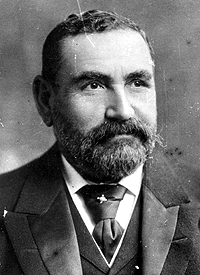
David Robert Hall was a politician and lawyer in New South Wales, Australia.

James Hayes was an Australian politician.
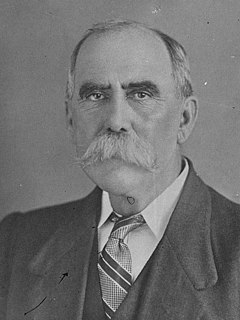
John Estell was a politician and coal miner in New South Wales, Australia. He was a member of the New South Wales Parliament for 29 years, including 20 years in the Legislative Assembly. He was a minister in the Holman, Storey and Dooley Labor governments.
The Donaldson ministry was the first ministry of the Colony of New South Wales, and was led by Stuart Donaldson. Despite the first free elections for the New South Wales Legislative Assembly being held in March 1856, it took over two months for Donaldson to form Government. It was sworn in on 6 June 1856, after the 1856 election and lasted just eighty days.
The second Cowper ministry was the fourth ministry of the Colony of New South Wales, and second occasion of being led by Charles Cowper.
The third Cowper ministry was the seventh ministry of the Colony of New South Wales, and third occasion of being led by Charles Cowper.

The third Robertson ministry was the fifteenth ministry of the Colony of New South Wales, and was led by John Robertson. It was the third of five occasions that Robertson was Premier. Robertson was elected in the first free elections for the New South Wales Legislative Assembly held in March 1856.
The fourth Robertson ministry was the seventeenth ministry of the Colony of New South Wales, and was led by Sir John Robertson. It was the fourth of five occasions that Robertson led the Government. Robertson was elected in the first free elections for the New South Wales Legislative Assembly held in March 1856.

The third Parkes ministry was the nineteenth ministry of the Colony of New South Wales, and was led by Sir Henry Parkes in a coalition with Sir John Robertson. It was the third of five occasions that Parkes was Leader of the Government.
The first Dibbs ministry was the 21st ministry of the Colony of New South Wales, and was the first of three occasions of being led by the Premier, George Dibbs. Dibbs was elected to the New South Wales Legislative Assembly in 1874.

The fifth Parkes ministry was the 26th ministry of the Colony of New South Wales, and was led by the seventh Premier, Sir Henry Parkes. It was the fifth and final occasion that Parkes was Premier. The title of Premier was widely used to refer to the Leader of Government, but was not a formal position in the government until 1920. Instead the Premier was appointed to another portfolio, usually Colonial Secretary. Having served in the New South Wales Legislative Council between 1854 and 1856, Parkes was elected in the first free elections for the New South Wales Legislative Assembly held in 1856, however resigned from Parliament later that year. He served in the Assembly on several occasions, between 1858 and 1870, being forced to resign on 4 occasions due to his personal insolvency. He came to power as Premier on the first occasion in 1872, serving as Premier for a period of three years. However, Parkes lost the confidence of the Assembly following Governor Robinson's decision to release of the bushranger Frank Gardiner led to the defeat of the ministry in 1875.

The third Dibbs ministry, the 27th ministry of the Colony of New South Wales, was led by Sir George Dibbs, leader of the Protectionist Party, following the 1891 New South Wales election, which saw the Labour Party win seats in the New South Wales Legislative Assembly and the balance of power. With no party having a majority, Sir Henry Parkes held on as Premier until October 1891 when he lost a vote in the Legislative Assembly, causing Parkes to resign as Premier and leader of the Free Trade Party. Dibbs formed the ministry on 23 October 1891, with Labour support, and comprised 10 ministers.
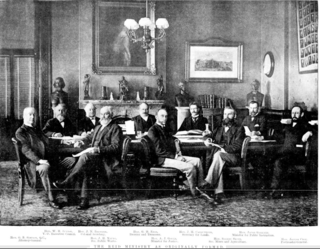
The Reid ministry was the 28th ministry of the Colony of New South Wales, and was led by the 12th Premier, George Reid. The title of Premier was widely used to refer to the Leader of Government, but was not a formal position in the government until 1920. Instead the Premier was appointed to another portfolio, usually Colonial Secretary but on this occasion Reid took the portfolio of Colonial Treasurer until July 1899 and then Attorney General.
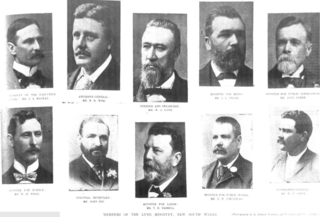
The Lyne ministry was the 29th ministry of the Colony of New South Wales, and was led by the 13th Premier, Sir William Lyne, KCMG.

The Waddell ministry was the 31st ministry of the New South Wales Government, and was led by the 15th Premier, Thomas Waddell. The title of Premier was widely used to refer to the Leader of Government, but was not a formal position in the government until 1920. Instead the Premier was appointed to another portfolio, usually Colonial Secretary, however in this case Waddell chose to retain his previous portfolio of Colonial Treasurer.

The Carruthers ministry was the 32nd ministry of the New South Wales Government, and was led by the 16th Premier, Joseph Carruthers. The title of Premier was widely used to refer to the Leader of Government, but was not a formal position in the government until 1920. Instead the Premier was appointed to another portfolio, usually Colonial Secretary. In this case, Carruthers chose the portfolio of Treasurer.

The Wade ministry was the 33rd ministry of the New South Wales Government, and was led by the 17th Premier, Charles Wade. The title of Premier was widely used to refer to the Leader of Government, but was not a formal position in the government until 1920. Instead the Premier was appointed to another portfolio and Wade chose to keep the portfolio of Attorney General he held in the Carruthers ministry.

The Storey ministry was the 37th ministry of the New South Wales Government, and was led by the 20th Premier, John Storey.
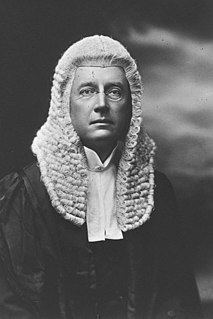
John Garland was a Scottish-born Australian politician.

Minister without portfolio or Honorary Minister' was the title given to a member of the Cabinet who did not have responsibility for a department or portfolio. They were not paid in addition to their allowance as a member of parliament. The title was first used in the Lyne ministry in 1901 when Paddy Crick ceased to be Postmaster-General as a result of the Federation of Australia and remained in the Cabinet until he was appointed Secretary for Lands in the See ministry. The first people appointed without a portfolio were James Hayes, and Walter Bennett in the See ministry. The ministers without a portfolio were often given specific responsibilities using section 36 of the Constitution of New South Wales under which the Governor could authorise any member of the cabinet to perform the duties of another minister, except for the Attorney General. The title was last used in the third Cahill ministry. From 1959 the title "minister assisting ..." or "assistant minister ..." has been used.
